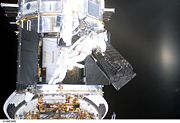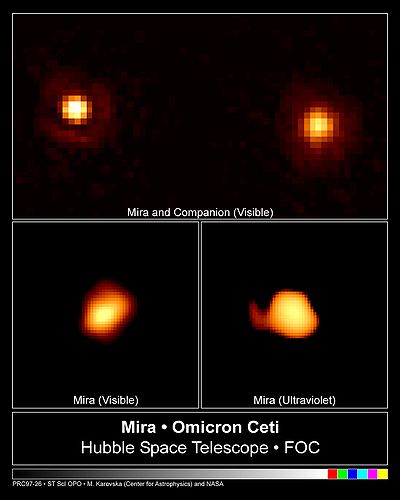
Faint Object Camera
Encyclopedia


Camera
A camera is a device that records and stores images. These images may be still photographs or moving images such as videos or movies. The term camera comes from the camera obscura , an early mechanism for projecting images...
installed on the Hubble Space Telescope
Hubble Space Telescope
The Hubble Space Telescope is a space telescope that was carried into orbit by a Space Shuttle in 1990 and remains in operation. A 2.4 meter aperture telescope in low Earth orbit, Hubble's four main instruments observe in the near ultraviolet, visible, and near infrared...
from launch in 1990 until 2002. It was replaced by the Advanced Camera for Surveys
Advanced Camera for Surveys
The Advanced Camera for Surveys is a third generation axial instrument aboard the Hubble Space Telescope . The initial design and scientific capabilities of ACS were defined by a team based at Johns Hopkins University. ACS was assembled and tested extensively at Ball Aerospace & Technologies Corp...
.
The camera was built by Dornier GmbH and was funded by the European Space Agency
European Space Agency
The European Space Agency , established in 1975, is an intergovernmental organisation dedicated to the exploration of space, currently with 18 member states...
. The unit actually consists of two complete and independent camera systems designed to provide extremely high resolution, exceeding 0.05 arcseconds. It is designed to view very faint UV light from 115 to 650 nanometers in wavelength.
The camera was designed to operate at low, medium, or high resolution. The angular resolution and field of view at each resolution were as follows:
| Angular resolution | Field of view | |
|---|---|---|
| Low resolution (f/48) F-number In optics, the f-number of an optical system expresses the diameter of the entrance pupil in terms of the focal length of the lens; in simpler terms, the f-number is the focal length divided by the "effective" aperture diameter... |
0.043 arcseconds | 22 arcseconds |
| Medium resolution (f/96) | 0.022 arcseconds | 11 arcseconds |
| High resolution (f/288) | 0.0072 arcseconds | 3.6 arcseconds |
Mira


